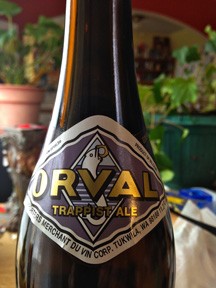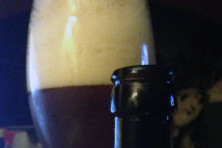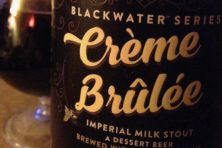Monky Beer
- Share
- Tweet
- Pin
- Share

A rotund bowling pin of a beer caught my eye the other day in the wall of beer. Its name – Orval – matches its shape. It looks Orvallian.
Orval is a 6.9 percent Trappist ale, which means its is brewed by Trappist monks. I think if one were inclined to join a religious order, the Trappists would be the way to go. They take Chapter 48 of The Rule of St. Benedict to heart, for it states, “for then are they monks in truth, if they live by the work of their hands.”
Some Trappist monks make cheese. Some make bread. And some in the Netherlands and Belgium make some of the best beer on Earth. Orval is one of them, well, sort of. The Trappists of the Abbaye Notre-Dame d’Orval don’t actually make the beer. Lay people are hired to make it. Still, I bet the brothers get a good taste.
This particular bottle came to life on April 15, 2013, and the label says it’s best before the same date in 2018. A five-year beer.
You can read about the detailed Orval brewing process on the website orval.be, but I’ll mention a few unusual steps, such as the liquid sugar candy added to the wort and the dry hopping in secondary fermentation. Three hop varieties are used: Bavarian Hallertau, Slovenian Styrian Golding and Alsacian Strisselspalt.
Before bottling, the beer is centrifuged to remove dead yeast, and then fresh yeast and liquid sugar is added to referment the beer in the bottle, so that when we crack open that portly bottle, we are left with a beer layered in flavors. A bright, fresh hoppiness rides on top of a dark sugar/molasses undercurrent. Very unique.
So I go back to the wall of beer and my gaze alights on another Trappist ale, Westmalle Dubbel and Tripel. Guess which one I chose…

Yup, the 9.5 percent Tripel.
The experience begins as I pour the bottle into a tulip glass and the golden liquor pours out with a heady floral aroma and a bright white rocky head. The taste is sweet and sharp effervescence, with delicious, not-yet discovered fruits on top of it all.
I found what I thought was the “born on” date on the bottle label. It read Oct. 29, 2014, and I thought, I’m drinking a beer of the future, but, as it turns out, there is no “born on” date on this bottle, only a “best before.”
Anyway, none of that really matters with beer of this quality, intensity and spirit, and by spirit, I refer to the philosophy that drives Trappist monks to make exquisite beer, as set down on the Westmalle website, trappistwestmalle.be, which lets you know there are but seven breweries on the entire planet that can carry the “Authentic Trappist Product” branding.
“Trappist beer is only given this name if it satisfies a number of strict criteria:
• The beer is brewed within the walls of a Trappist abbey, by the monks themselves or under their supervision.
• The brewery must be controlled by the monastery and have a business culture compatible with the monastic project.
• The purpose of the brewery is not to make a profit. The income takes care of the livelihood of the monks and the upkeep of the abbey site. What is left over is used for charitable purposes, social work and people in need.”
So, in short, these Trappists are good people. They don’t talk much and they make great beer.
* * *
I mentioned recently the purchase of a six-pack of beer that was far too happy for my taste – Lagunitas’ Brown Shugga Substitute Ale. Hops are the definite star of this “beer,” and I always prefer hops to be a supporting character of the real star, the grains. So I decided to reserve the five remaining bottles for cooking. With my first cooking experiment using Brown Shugga Substitute Ale, I found that hop juice makes a very interesting gravy.
I made slow-cooked pork rib chops in the crockpot, with two finely sliced onions, which added sweetness to the dish. Instead of using white wine for the sauce as the recipe called for, I used the Lagunitas, which imparted a floral aroma and a definite herbal taste to the creamy sauce and the succulent chops.
I also tried the hopped up beer in a non-slowcooked chicken stock gravy and it did not work. The hop flavor overpowered every other ingredient. I’ll try it in a beef gravy next. At least there is hope for overhopped beers other than plant food.


